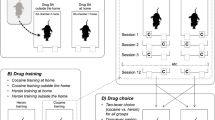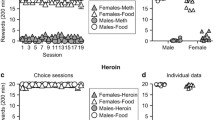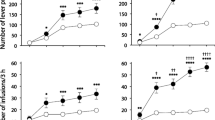Abstract
Rationale
A high incidence of relapse can be triggered by exposure to conditioned cues previously associated with heroin. Extended access to drug and withdrawal are thought to affect the motivation for drug seeking.
Objectives
The present study evaluated how different periods of training to self-administer heroin and different periods of withdrawal affected drug seeking.
Materials and methods
Following 1 to 14 days of heroin self-administration, rats were left in the home environment for 1 or 14 days. Subsequently, rats were evaluated for extinction of nose poke during the first hour after being returned to the training apparatus. One hour later, a conditioned stimulus was presented to initiate cue-induced reinstatement.
Results
Extending the training period from 1 to 14 days caused an escalation of reinstatement of drug seeking induced by conditioned cues. Increasing the withdrawal period from 1 to 14 days produced a similar increase in reinstatement of drug seeking induced by cues. Reinstatement of drug seeking induced by cues was augmented by pretreatment with naltrexone (1, 5 mg/kg) 24 h prior to reinstatement on day 1, but not at 14 days of withdrawal from heroin self-administration.
Conclusions
These experiments demonstrate that increasing the duration of either heroin self-administration or the withdrawal periods from heroin self-administration augments the reinstatement induced by cues that were associated previously with heroin reinforcement. Additionally, we provide one of the first demonstrations that opiate withdrawal induces heroin seeking, as assessed in the reinstatement model.



Similar content being viewed by others
References
Ahmed SH, Koob GF (1998) Transition from moderate to excessive drug intake: change in hedonic set-point. Science 282:298–300
Ahmed SH, Wakler JR, Koob GF (2000) Persistent increase in the motivation to take heroin in rats with a history of drug escalation. Neuropsychopharmacology 22:413–421
Ahmed SH, Kenny PJ, Koob GF, Markou A (2002) Neurobiological evidence for hedonic allostasis associated with escalating cocaine use. Nat Neurosci 5:625–626
Childress AR, McLellan AT, O’Brien CP (1986) Abstinence opiate abusers exhibit conditioned craving, conditioned withdrawal and reductions in both through extinction. Br J Addic 81:655–660
de Wit H, Stewart J (1983) Drug reinstatement of heroin-reinforced responding in the rats. Psychopharmacology 79:29–31
Di Ciano P, Everitt BJ (2003) Differential control over drug-seeking behavior by drug-associated conditioned reinforcer and discriminative stimuli predictive of drug availability. Behavioral Neuroscience 117:952–960
Epstein RL, Stewart J, Shaham Y (2006) Toward a model of drug relapse: an assessment of the validity of the reinstatement procedure. Psychopharmacology 189:1–16
Ferrario CR, Gorny G, Crombag HS, Li Y, Kolb B, Robinson TE (2005) Neural and behavioral plasticity associated with the transition from controlled to escalated cocaine use. Biol Psychiatry 58:751–759
Grimm JW, Hope BT, Wise RA, Shaham Y (2001) Incubation of cocaine craving after withdrawal. Nature 412:141–142
Hellemans KGC, Dickinson A, Everitt BJ (2006) Motivational control of heroin seeking by conditioned stimuli associated with withdrawal and heroin taking by rats. Behav Neurosci 120:103–114
Himmelsbach DK (1942) Clinical studies of drug addiction. Physiological dependence, withdrawal and recovery. Arch Inter Med 69:766–772
Hutcheson DM, Everitt BJ, Robbins TW, Dickinson A (2001) The role of withdrawal in heroin addiction: enhances reward or promotes avoidance. Nat Neurosci 4:943–947
Katz JL, Higgins ST (2003) The validity of the reinstatement model of craving and relapse to drug use. Psychopharmacology (Berl) 168:21–30
Kenny PJ, Chen SA, Kitamura O, Markou K, Koob GF (2006) Conditioned withdrawal drives heroin consumption and decrease reward sensitivity. J Neurosci 26:5894–5900
Knackstedt L, Kalivas PW (2007) Extended access to cocaine self-administration enhances drug-primed reinstatement but no behavioral sensitization. J Pharmacol Exp Ther 322:1103–1109
Koob GF, Le Moal M (2005) Plasticity of reward neurocircuitry and the “dark side” of drug addiction. Nat Neurosci 8:1442–1444
Lu L, Chen H, Su W, Ge X, Yue W, Su F, Ma L (2005) Role of withdrawal in reinstatement of morphine-conditioned place preference. Psychopharmaoclogy (Berl) 181:90–100
Martin WR, Jasinski DR (1969) Physiological parameters of morphine dependence in man-tolerance, early withdrawal, protracted abstinence. J Psychiar Res 7:9–17
Meyer RE, Mirin SM, Altman JL (1975) The clinical usefulness of narcotic antagonists implications of behavioral research. Am J Drug Alcohol Abuse 2:417–432
O’Brien CP, Testa T, O’Brien TJ, Brady JP, Wells B (1977) Conditioned narcotic withdrawal in humans. Science 195:1000–1002
Schmidt ED, Voorn P, Binnekade R, Schoffelmeer AN, De Vries TJ (2005) Differential involvement of the prelimbic cortex and striatum in conditioned heroin and sucrose seeking following long-term extinction. Eur J Neurosci 22:2347–2356
See RE (2002) Neural substrates of conditioned-cued relapse to drug-seeking behavior. Pharmacol Biochem Behav 71:517–529
Shaham Y, Stewart J (1995) Stress reinstates heroin-seeking in drug-free animals: an effect mimicking heroin, not withdrawal. Psychopharmacology (Berl) 119:334–341
Shaham Y, Rajabi H, Stewart J (1996) Relapse to heroin-seeking in rats under opioid maintenance: the effects of stress, heroin priming, and withdrawal. J Neurosci 16:1957–1963
Shaham Y, Shalev U, Lu L, De Wit H, Stewart J (2003) The reinstatement model of drug relapse: history, methodology and major findings. Psychopharmacology (Berl) 168:3–20
Shalev U, Morales M, Hope B, Yap J, Shaham Y (2001) Time-dependent changes in extinction behavior and stress-induced reinstatement of drug seeking following withdrawal from heroin in rats. Psychopharmacology 156:98–107
Tran-Nguyen LT, Fuchs RA, Coffey GP, Baker DA, O’Dell LE, Neisewander JL (1998) Time-dependent changes in cocaine-seeking behavior and extracellular dopamine levels in the amygdala during cocaine withdrawal. Neuropsychopharmacology 19:48–59
Wikler A (1973) Dynamics of drug dependence. Implications of a conditioning theory for research and treatment. Arch Gen Psychiatry 28:611–616
Wikler A, Pescor FT (1967) Classical conditioning of a morphine abstinence phenomenon, reinforcement of opioid-drinking behavior and “relapse” in morphine addicted rats. Psychopharmacologia 20:255–284
Zhang F, Zhou W, Tang S, Liu H, Lai M, Zhu H, Yang G (2004) Motivation of heroin-seeking elicited by drug-associated cues is related to total amount of heroin exposure during self-administration in rats. Pharmacol Biochem Behav 79:291–298
Zhou W, Kalivas PW (2008) N-acetylcysteine reduces extinction responding and induces enduring reductions in cue- and heroin-induced drug-seeking. Biol Psychiatry 63:338–340
Zhou W, Zhang F, Tang S, Liu H, Lai M, Yang G (2004) Low dose of heroin inhibits drug-seeking elicited by cues after prolonged withdrawal from heroin self-administration in rats. NeuroReport 15:727–730
Zhou W, Zhang F, Tang S, Liu H, Gu J, Yang G (2005) The dissociation of heroin-seeking patterns induced by contextual, discriminative, or discrete conditioned cues in a model of relapse to heroin in rats. Psychopharmacology (Berl) 181:197–206
Zhou W, Liu H, Zhang F, Tang S, Zhu H, Lai M, Kalivas PW (2007) Role of acetylcholine transmission in nucleus accumbens and ventral tegmental area in heroin-seeking induced by conditioned cues. Neuroscience 144:1209–1218
Acknowledgments
This work was supported by the National Basic Research Program of China (2003CB515404; 2009CB522008), Nature Science Foundation of China (30470554, 30670675) and Zhejiang (D2080515), and United States Public Health Service Grant #DA 015369 and sponsored by the Zhejiang Provincial High-level Innovative Health Talents.
Author information
Authors and Affiliations
Corresponding author
Rights and permissions
About this article
Cite this article
Zhou, W., Zhang, F., Liu, H. et al. Effects of training and withdrawal periods on heroin seeking induced by conditioned cue in an animal of model of relapse. Psychopharmacology 203, 677–684 (2009). https://doi.org/10.1007/s00213-008-1414-2
Received:
Accepted:
Published:
Issue Date:
DOI: https://doi.org/10.1007/s00213-008-1414-2




